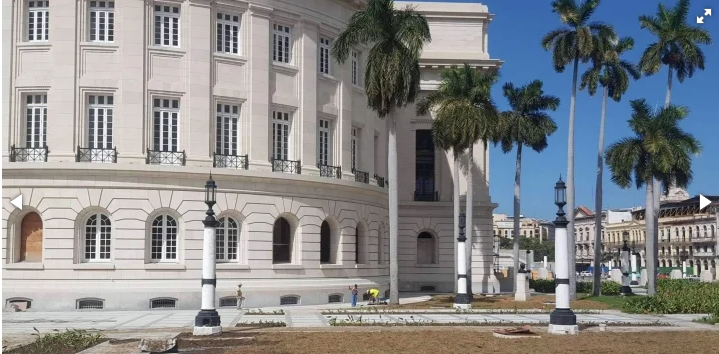
Cubanet, Miriam Celaya, Havana, 4 November 2019 — There are those who would swear that everything in Cuba, from the most solemn to the most mundane act, has an air of a one-act farce. The dramatic and the jocular intermingle in a scenario full of contrasts and absurdities, in a reality that far exceeds any fiction plot.
These days, the metal fences that covered the gardens of the southern area of the National Capitol were finally removed, and the neighbors who reside in the popular (and populous) neighborhood that runs behind the monumental building, glance curiously at the feverish restoration activity. There is an intense agitation, since there are only two weeks left for the 500th Anniversary of the Cuban capital, to be celebrated on November 16th, and the delivery of this iconic building is one of the highlights of the event.
“I think they will not finish it on time”, says a septuagenarian of humble appearance who says he is a retired construction frame worker, who returns daily to contemplate the work. “I, who worked all my life in construction, tell you that a lot of work is still missing. Now they are in earthworks because they removed all the old tiles in the garden in order to restore them. Then they have to tamp, press them firmly and fuse them so that these tile slabs remain fixed. Add to that all the landscaping, and not counting the windows that have yet to be installed and the facade that is still covered and must be finished.”
And he points to a huge mesh cloth that covers a portion of the rear facade and numerous empty openings where all the blinds should already be in place. “They are going to have to work in 24-hour shifts and still doing it that way they might be able to complete just what shows. Just cosmetic work, the same as always happens.”
Nearby, there is a standing policeman on duty facing the work. Police surveillance is permanent, as well as the presence of guards at a nearby checkpoint, to prevent the usual shoplifting of construction materials: the illegal sale of cement, stone dust, joists, etc., is a constant in every construction job in Cuba.
“This has been difficult here from the beginning,” says a lady who also watches the work. “I live here back on Amistad Street, and several neighbors of mine tried to get some cement and other things… but nothing. There is great vigilance with that, and there are people in this neighborhood whose houses need repairs, because they are falling down… There are no materials for the unfortunate.”
Occasionally, some official media have made reference to the intervention of foreign capital and the support of private institutions to achieve the restoration of this building, paradoxically the most important symbol of Republican Cuba, crushed after the 1959 revolution.
The Castro regime, unable to create their own symbols that can compete in quality and beauty with those of the past, is trying now to appropriate allegories that are completely alien to them. Since they failed to completely destroy the city that they despise – and those who despise them – they prefer to make use of its meaning and its unyielding architectural wealth.
According to government sources, the German company MD Projektmanagement, owned by Michel Diegmann, is responsible for the restoration work. However, nobody fully knows the total amount of the investment, although everyone infers that the sum must be in the millions. “With half the money that this cost, a lot of buildings in Centro Habana could have been repaired,” the same woman muses next to me.
The restoration of the dome alone, exquisitely coated with pieces of gold leaf on copper sheets, is the result of a large donation from the Russian Federation. The work undertaken to return it to its former splendor was carried out by specialists from that country, assisted by Cuban personnel.

Re-inaugurated August 30th by the City Historian, the golden dome contrasts sharply since then with the poverty of its “backyard”, that is, the collapsed roofs and facades of the adjoining buildings, hidden behind the architectural magnificence not only of the Capitol, but also of the Havana Prado, the Havana Lyceum, the Grand Theater, the Saratoga Hotel, the Fountain of the Indian Woman, and the Central and Fraternity parks. A majestic urban complex that flanks and conceals the ugly face of gloom, the crust of decay, accentuated after 60 years of neglect that the authorities do not want the world to see.
And it is not that it is wrong to rescue those symbols, buildings, squares and spaces that made this city beautiful; quite the opposite. We just need to not forget that Havana, like any city, is much more than the sum of its architectural symbols and historical spaces.
The beauty of cities, what makes them peculiar or “marvelous”, lies in the soul of their people, in the spirit of those who inhabit them. To artificially brighten the old trappings of our city for one occasion, as if it were a showcase to display it to the world, while prosperity and freedoms are still forbidden to Cubans who live it, love it and suffer it, it’s not worth a thing.

